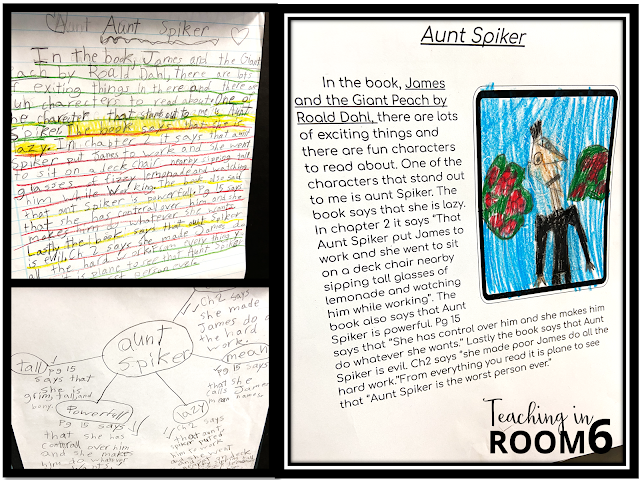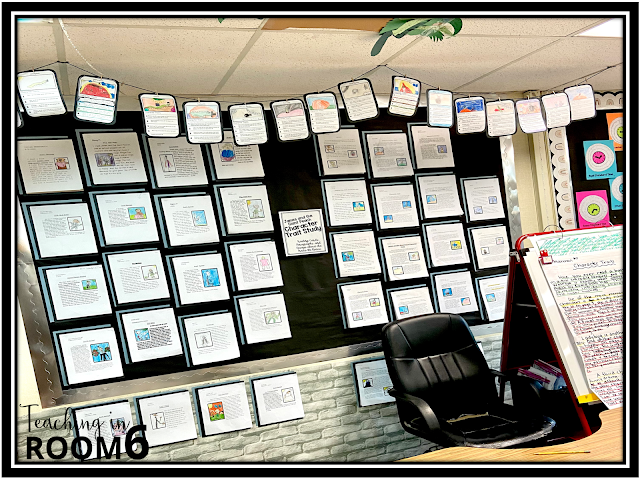We have been focusing a lot on character traits in class these past few months. As a reader, focusing on the traits that an author chooses to share with us about the characters in the book really helps us to understand the story as a whole. So when we began reading our shared novel, James and the Giant Peach, we set out to really understand the character traits that Roald Dahl was giving us.
I wanted the kids to have several opportunities to respond to the literature we were reading. So we did three different responses, all building upon the skills from the previous one. We made a "trading card", wrote one paragraph, and then wrote an essay (which we then put altogether on one big bulletin board!) Here is how we did it.
First Response: Character Trading Card
After reading several chapters, the students created bubble maps describing the character traits of the human-sized bugs. I modeled how to do this using the main character of James Henry Trotter. I showed them how to create the bubble map and add evidence from the tex to support their character trait assumptions. I had them work in groups to create the bubble maps for the bugs, with each of six groups taking on one bug and finding the traits that described that bug as well as citing evidence from the text.
Then, the students were tasked with creating a "Trading Card" (which ended up looking like an iPad) for TWO different bug characters listing 4 character traits and the accompanying evidence from the text. They loved making these mostly because they were fairly easy to do ;) The kids were able to use the bubble maps and dig into the text a bit. You can grab the digital Trading Card file here.
Second Response: Single Paragraph
Next, the students created their own bubble maps about one human character in the book. They did the same basic thing as the bugs, but this time it was on their own. They had to look through the chapters and find evidence to support the character traits embodied within either Aunt Spiker, Aunt Sponge, or the Old Man. (Since I modeled in the previous response using James, they were not allowed to use that character.) Once they had the evidence on their bubble maps, they used this paragraph organizer to write a single paragraph about their chosen character, citing evidence for the character traits in the text. They then published their paragraphs on Google Docs. I asked them to insert a blank box (just using the "search the web" feature when inserting an image) and they drew a picture of the character once they printed it out.
Final Response: 5 Paragraph Essay
Once I read the paragraphs, it was clear that the students needed a bit more work crafting sentences describing the character traits and the evidence within the text. I asked them to really think about not only the evidence, but how that evidence really did support the trait. Instead of writing, "The bug is nice. On page 5 is says he smiles at people." I wanted them to be more descriptive. So they could write, "One of the character traits that bug exhibits is being a really nice guy. On page 5 it says that he smiles at everyone who walks by. That is definitely something that nice people would do."
For this essay, I asked them to write a paragraph about one of the humans and then two additional paragraphs about two of the bugs. They needed to use DIFFERENT characters than they had previously written about. I did allow them to use the bubble maps that were made already, so that step was taken care of. I also allowed them to use James as the human if they wished.
Since the third graders haven't written too many five paragraph essays, I guided them through the process of writing this. I modeled the types of sentences they should included. While the work that I was writing wasn't exactly specific or truthful to the book (I didn't want them to copy so I made facts up), the style and sentence types I was using were good models for them.
And when the final product came out, it was evident that the modeling of how to really show character traits from the story really helped. The essays were very detailed, were clear and concise, and really showed a deep understanding of the characters!
Overall, I am so pleased with how this all came out. The kids are really understanding the importance of character traits in developing a story, have some great writing, and I have an awesome bulletin board for our classroom!








No comments
Post a Comment
Please leave a comment! I love to hear what you think about what is posted :)